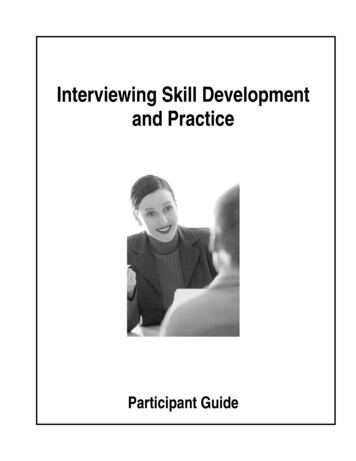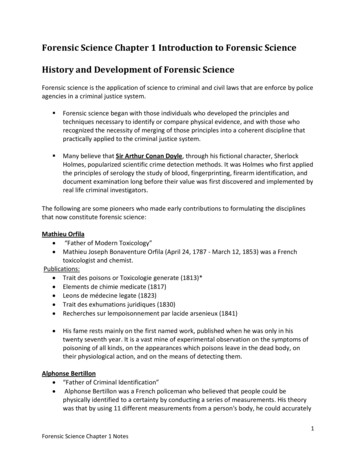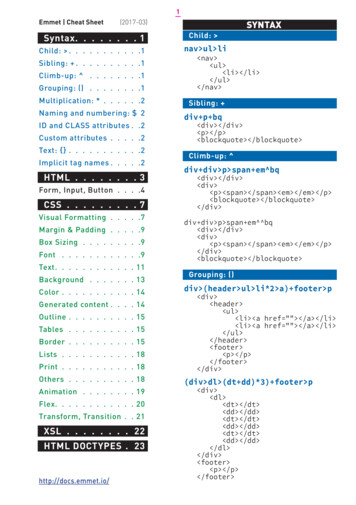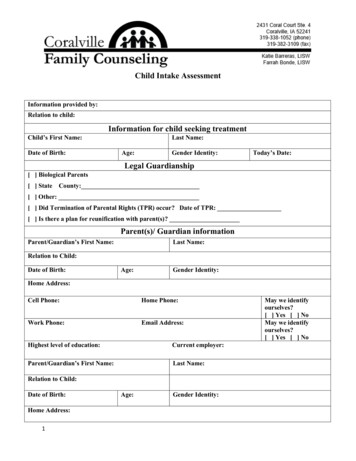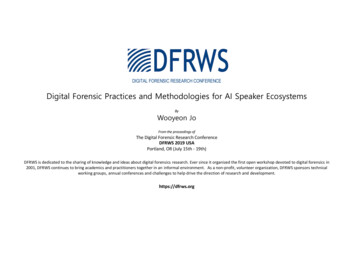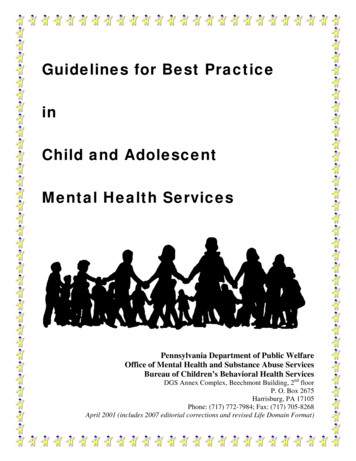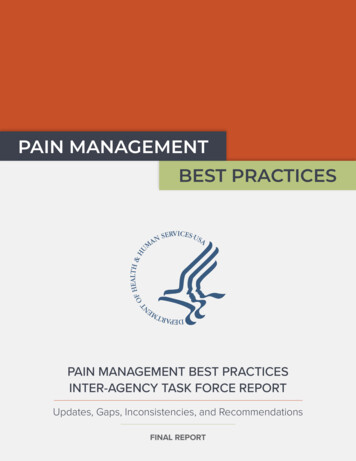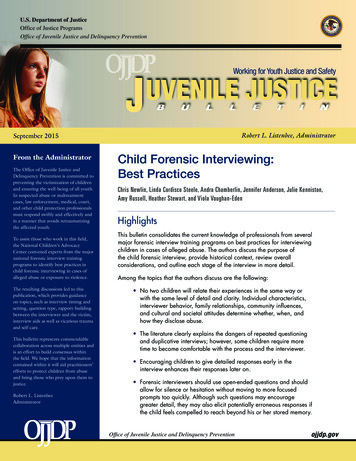
Transcription
U.S. Department of JusticeOffice of Justice ProgramsOffice of Juvenile Justice and Delinquency PreventionRobert L. Listenbee, AdministratorSeptember 2015From the AdministratorThe Office of Juvenile Justice andDelinquency Prevention is committed topreventing the victimization of childrenand ensuring the well-being of all youth.In suspected abuse or maltreatmentcases, law enforcement, medical, court,and other child protection professionalsmust respond swiftly and effectively andin a manner that avoids retraumatizingthe affected youth.To assist those who work in this field,the National Children’s AdvocacyCenter convened experts from the majornational forensic interview trainingprograms to identify best practices inchild forensic interviewing in cases ofalleged abuse or exposure to violence.The resulting discussions led to thispublication, which provides guidanceon topics, such as interview timing andsetting, question type, rapport-buildingbetween the interviewer and the victim,interview aids as well as vicarious traumaand self-care.This bulletin represents commendablecollaboration across multiple entities andis an effort to build consensus withinthe field. We hope that the informationcontained within it will aid practitioners’efforts to protect children from abuseand bring those who prey upon them tojustice.Robert L. ListenbeeAdministratorChild Forensic Interviewing:Best PracticesChris Newlin, Linda Cordisco Steele, Andra Chamberlin, Jennifer Anderson, Julie Kenniston,Amy Russell, Heather Stewart, and Viola Vaughan-EdenHighlightsThis bulletin consolidates the current knowledge of professionals from severalmajor forensic interview training programs on best practices for interviewingchildren in cases of alleged abuse. The authors discuss the purpose ofthe child forensic interview, provide historical context, review overallconsiderations, and outline each stage of the interview in more detail.Among the topics that the authors discuss are the following: No two children will relate their experiences in the same way orwith the same level of detail and clarity. Individual characteristics,interviewer behavior, family relationships, community influences,and cultural and societal attitudes determine whether, when, andhow they disclose abuse. The literature clearly explains the dangers of repeated questioningand duplicative interviews; however, some children require moretime to become comfortable with the process and the interviewer. Encouraging children to give detailed responses early in theinterview enhances their responses later on. Forensic interviewers should use open-ended questions and shouldallow for silence or hesitation without moving to more focusedprompts too quickly. Although such questions may encouragegreater detail, they may also elicit potentially erroneous responses ifthe child feels compelled to reach beyond his or her stored memory.Office of Juvenile Justice and Delinquency Preventionojjdp.gov
SEPTEMBER 2015Child Forensic Interviewing: Best PracticesChris Newlin, Linda Cordisco Steele, Andra Chamberlin, Jennifer Anderson, Julie Kenniston, Amy Russell, Heather Stewart,and Viola Vaughan-EdenDuring the last quarter of the 20th century, the UnitedStates began to fully recognize the incidence of childabuse and neglect affecting our country. Increased publicawareness and empirical literature have improved effortsto intervene effectively on behalf of children. One ofthe most significant interventions has centered on howto elicit accurate information from children regardingabuse and neglect—a process commonly referred to as“forensic interviewing” (Saywitz, Lyon, and Goodman,2011). Following two decades of research and practice,professionals have gained significant insight into howto maximize children’s potential to accurately conveyinformation about their past experiences. Yet, as this effortcontinues and practice evolves, professionals face newchallenges in standardizing forensic interviewing practicethroughout the country.A relative lack of both research and practice experiencechallenged pioneers in the field. As such, protocols andtraining efforts underwent significant revisions as moreresearch was conducted and people began gaining practicebased experience, which informed further training.Additionally, given the dearth of resources at the time,geographically diverse training programs began to developnaturally throughout the United States, emanating fromfrontline service providers who struggled to providequality services themselves and who also wanted to helpfellow professionals. Different case experiences, contextualperspectives, and community standards influenced thesetraining efforts. In addition, these service providers werenot directly communicating with one another about thecontent of their training or their theoretical approaches.This further supported the existence of various approachesand the lack of standardized training language regardingforensic interviewing.2Juvenile Justice BulletinIt is now widely accepted that professionals should haveformal initial and ongoing forensic interview training(National Children’s Alliance [NCA], 2011). However,the field has yet to determine one standardized practiceto follow throughout the country. Although nationaltraining programs are generally based on the same bodyof research, some differences exist. Focusing on thevariations among them often obscures consistencies withinthe various forensic interview models. In some cases, theveracity of the child’s statement or the performance ofthe forensic interviewer has been questioned solely onthe basis of the model being used. However, forensicinterviewers often receive training in multiple models anduse a blended approach to best meet the needs of thechild they are interviewing (Midwest Regional Children’sAdvocacy Center [MRCAC], 2014). Furthermore, themodel being used and any subsequent adaptations to it areoften rooted in jurisdictional expectations. State statutesand case law dictate aspects of interview practice, furtherdemonstrating that no one method can always be the bestchoice for every forensic interview.In 2010, representatives of several major forensic interviewtraining programs—the American Professional Societyon the Abuse of Children, the CornerHouse InteragencyChild Abuse Evaluation and Training Center, theGundersen National Child Protection Training Center, theNational Children’s Advocacy Center, and the NationalInstitute of Child Health and Human Development—gathered to review their programs’ differences andsimilarities. The resulting discussions led to this bulletin,which consolidates current knowledge on the generallyaccepted best practices of those conducting forensicinterviews of children in cases of alleged abuse or exposureto violence.
This nation must remain committed to consistentlyputting the needs of children first. It is the authors’ hopethat this document will become an essential part of everyforensic interview training program and will be widelyused as an authoritative treatise on the implementation ofbest practices in forensic interviewing.Purpose of the Child ForensicInterviewThe forensic interview is one component of acomprehensive child abuse investigation, which includes,but is not limited to, the following disciplines: lawenforcement and child protection investigators, prosecutors,child protection attorneys, victim advocates, and medicaland mental health practitioners. Although not all of theconcerned disciplines may directly participate in or observethe forensic interview, each party may benefit from theinformation obtained during the interview (Jones et al.,2005).Most child abuse investigations begin with a forensicinterview of the child, which then provides directionfor other aspects of the investigation. Although forensicinterviewers are trained to conduct quality interviews, it isimportant to note there is no “perfect” interview.For the purposes of this bulletin, and in an effort to buildconsensus within the field, the authors offer the followingdefinition of a child forensic interview:A forensic interview of a child is a developmentallysensitive and legally sound method of gatheringfactual information regarding allegations of abuse orexposure to violence. This interview is conducted bya competently trained, neutral professional utilizingresearch and practice-informed techniques as part ofa larger investigative process.Historical ContextIn the 1980s, several high-profile cases involvingallegations that daycare providers had sexually abusedmultiple children in their care became the subject ofconsiderable analysis because of the interview techniquesthat were used (Ceci and Bruck, 1995). Law enforcementdepended on mental health practitioners because of theirability to establish rapport with children. However, mentalhealth practitioners often used therapeutic techniques thatwere later deemed inappropriate for forensic purposes,primarily because of concerns regarding suggestibility.The courts scrutinized the interview procedures used inthese early cases and found that techniques that invitedmake-believe or pretending were inappropriate for criminalinvestigations.As awareness of child abuse grew, professionals realizedthat it might take special skills to interview children. Sgroi(1978) was the first medical/mental health professionalto address the issue of investigative interviewing in theliterature. The American Professional Society on theAbuse of Children (APSAC) wrote the first practiceguidelines—Psychosocial Evaluation of Suspected SexualAbuse in Young Children (APSAC, 1990)—the title ofwhich reflects the initial focus of these interviews: mentalhealth. Today, the focus has shifted from the mental healthor clinical perspective to a forensic perspective. Even thenomenclature changed to include terms such as “forensicinterview” and “child forensic interview training.”In the late 1980s and early 1990s, substantial empiricalliterature discussed children’s developmental capabilitiesand appropriate ways of engaging them in the interviewprocess. The Cognitive Interview (Fisher and Geiselman,1992) and Narrative Elaboration (Saywitz, Geiselman,and Bornstein, 1992) models included specific strategiesthat applied memory-based techniques to elicit detailedinformation from witnesses. Traces of both modelsremain in current approaches to evidence-based forensicinterviewing (Saywitz and Camparo, 2009; Saywitz, Lyon,and Goodman, 2011).Considerations Regardingthe ChildMany influences have an impact on a child’s experienceof abuse and on his or her ability to encode andcommunicate information. These influences interact in auniquely individual manner, such that no two children willever engage or relate their experiences in the same wayor with the same level of detail and clarity. This sectiondescribes the major influences on children’s memory,language abilities, and motivation to converse.DevelopmentAll of the forensic interviewing models agree thatconsidering the age and development of the child isessential. Lamb and colleagues (2015) state that “age isthe most important determinant of children’s memorycapacity.” A child’s age and developmental abilitiesinfluence his or her perception of an experience and theamount of information that they can store in long-termmemory (Pipe and Salmon, 2002). Infants and toddlerscan recall experiences, as demonstrated through behavioralreactions to people, objects, and environments; however,these early memories are not associated with verbaldescriptions. Even as they begin to develop their languageJuvenile Justice Bulletin3
those who evaluate the statements that children makein a legal context would do well to appreciate the manyextraordinary demands made on child witnesses.capabilities, young children are less able to make sense ofunfamiliar experiences, have a more limited vocabulary,and are less accustomed to engaging in conversationsabout past experiences than older children. As childrenage, their attention span improves and they are betterprepared to comprehend, notice unique elements, anddescribe their experiences verbally. This, in turn, allowsthem to store more information and also allows them todiscuss remembered events with others, which furtherserves to consolidate and strengthen memories. Childrenof all ages are more likely to recall salient and personallyexperienced details rather than peripheral details (Perona,Bottoms, and Sorenson, 2006).Metacognition—the ability to recognize whether oneunderstands a question and has stored and can retrieverelevant information—also improves as children mature.Very young children find it difficult to focus their attentionand to search their memory effectively when interviewed.They may simply respond to recognized words or simplephrases without considering the entire question, and theyare unable to monitor their comprehension or answers toquestions (Lamb et al., 2015). As children grow older,both natural development and knowledge gained fromschool improve their skills.Remembering an experience does not ensure that a childwill be able to describe it for others. Forensic interviewsare challenging for children, as they involve very differentconversational patterns and an unfamiliar demand fordetail (Lamb and Brown, 2006). Young children may usewords before they completely understand their meaningand may continue to confuse even simple concepts andterms such as “tomorrow,” “a lot,” or “a long time.” Aschildren mature, they acquire the ability to use words ina more culturally normative way, although terminologyfor sexual encounters, internal thoughts and feelings, andparticularly forensic and legal matters may be beyondtheir grasp (Walker, 2013). Forensic interviewers and4Juvenile Justice BulletinAlthough concerns about younger children’s verbaland cognitive abilities are well recognized, thechallenges of effectively interviewing adolescents areoften overlooked. Because adolescents look much likeadults, forensic interviewers and multidisciplinary teammembers may fail to appreciate that adolescents varygreatly in their verbal and cognitive abilities and thusfail to build rapport, provide interview instructions,or ensure the comprehension of questions (Walker,2013). Ever conscious of wanting to appear competent,adolescents may be reluctant to ask for assistance.Forensic interviewers and investigators must guard againstunreasonably high expectations for teenage witnessesand should not adopt a less supportive approach or useconvoluted language, which will complicate matters.Culture and DevelopmentA child’s family, social network, socioeconomicenvironment, and culture influence his or herdevelopment, linguistic style, perception of experiences,and ability to focus attention (Alaggia, 2010). Culturaldifferences may present communication challenges and canlead to misunderstandings within the forensic interview.Fontes (2008) highlights the importance of havingclear-cut guidelines and strategies for taking culture intoaccount when assessing whether child abuse or neglecthas occurred. Forensic interviewers and investigatorsmust consider the influence of culture on perception ofexperiences, memory formation, language, linguistic style,comfort with talking to strangers in a formal setting, andvalues about family loyalty and privacy when questioningchildren and evaluating their statements (Fontes, 2005,2008; Perona, Bottoms, and Sorenson, 2006).DisabilitiesChildren with disabilities are potentially at greater riskfor abuse and neglect than children without disabilities(Hershkowitz, Lamb, and Horowitz, 2007; KendallTackett et al., 2005). Forensic interviewers are unlikely
“Cultural differences may present communication challengesand can lead to misunderstandings within the forensic interview.”to have specialized training or experience in the broadfield of disabilities or regarding developmental or medicalconcerns; thus, collaboration is often necessary tosuccessfully interview these children. Interviewers shoulduse local resources—including disability specialists orother professionals who work with children and theirprimary caregivers—to gain insight into the functioningof specific children and any needs they may have forspecial accommodations (Davies and Faller, 2007). Theinterviewer may have to adapt each stage of the interview,balancing these adaptations with the demand for forensicintegrity (Baladerian, 1997; Hershkowitz, Lamb, andHorowitz, 2007). More than one interview session maybe necessary to gain the child’s trust, adapt to the child’scommunication style and limitations, and allow adequatetime to gather information (Faller, Cordisco Steele, andNelson-Gardell, 2010).TraumaChildren who have been victims of maltreatment or werewitnesses to violent crime often react uniquely to theirexperiences. Forensic interviewers must be cognizant offactors that mitigate or enhance the impact, as traumasymptoms may interfere with a child’s ability or willingnessto report information about violent incidents (Ziegler,2002). The memories of children who have sufferedextreme forms of trauma may be impaired or distorted(Feiring and Tasca, 2005); these children may not recalltheir experiences in a linear fashion but, instead, as“flashbulb memories” or snapshots of their victimization(Berliner et al., 2003). In addition, their memories oftraumatic experiences may be limited, with a particularemphasis on central rather than peripheral details (Fivush,Peterson, and Schwarzmueller, 2002). Interviewers andthose involved in investigating child abuse may need tomodify their expectations of what a traumatized childis able to report. They should not attempt to force adisclosure or continue an interview when a child becomesoverly distressed, which may revictimize the child.Children who are severely traumatized may benefit fromadditional support and multiple, nonduplicative interviewsessions (Faller, Cordisco Steele, and Nelson-Gardell,2010; La Rooy et al., 2010).DisclosureUnderstanding the disclosure process is critical for boththe investigative process and child protection outcomes.Research to date on children’s disclosure of sexual abuse—based mainly on retrospective surveys of adults and reviewsof past child abuse investigations—indicates that no singlepattern of disclosure is predominant (Lyon and Ahern,2010). Disclosure happens along a continuum rangingfrom denial to nondisclosure to reluctant disclosure toincomplete disclosure to a full accounting of an abusiveincident (Olafson and Lederman, 2006). Some childrenalso disclose less directly, over a period of time, through avariety of behaviors and actions, including discussions andindirect nonverbal cues (Alaggia, 2004).The interaction of individual characteristics, interviewerbehavior, family relationships, community influences, andcultural and societal attitudes determines whether, when,and how children disclose abuse (Alaggia, 2010; Bottoms,Quas, and Davis, 2007; Hershkowitz et al., 2006; Lyonand Ahern, 2010). Factors that help to explain a child’sreluctance are age, relationship with the alleged offender,lack of parental support, gender, fear of consequencesfor disclosing, and fear of not being believed (Malloy,Brubacher, and Lamb, 2011; McElvaney, 2013). A reviewof contemporary literature reveals that when disclosuredoes occur, significant delays are common. In a recentanalysis of child sexual abuse disclosure patterns, Alaggia(2010) found that as many as 60 to 80 percent of childrenand adolescents do not disclose until adulthood. If outsidecorroborative evidence exists (e.g., physical evidence,offender confessions, recordings, witness statements),there is still a high rate of nondisclosure (Lyon, 2007;Sjoberg and Lindblad, 2002). Furthermore, childrenwho disclose often do not recount their experiencesfully and may, over time, provide additional information(McElvaney, 2013).Current literature on children’s disclosure of sexualabuse has implications for practice. According to Mallo
the various forensic interview models. In some cases, the veracity of the child’s statement or the performance of the forensic interviewer has been questioned solely on the basis of the model being used. However, forensic interviewers often receive training in multiple models

